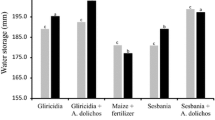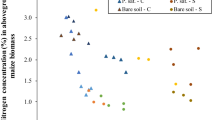Abstract
Improved fallows with leguminous trees have been developed in Southern Africa as a viable alternative to inorganic fertilizers but the changes in soil properties that are responsible for crop productivity improvement and implications of mixing litter and fresh leaves from the same tree species on soil fertility are not fully understood. Our objectives were to quantify (1) some changes in soil properties that are responsible for crop production improvement under improved fallow systems; (2) the N mineralization patterns of mixtures of litter and fresh leaves from the same tree species. The treatments used in the study were 2-year planted Sesbania sesban (sesbania) and Cajanus cajan (cajanus) and controls of natural fallow, continuous fertilized and unfertilized maize. At fallow clearing sesbania contributed 56 kg N ha−1 through litter and fresh leaves. Sesbania (fresh leaves + litter) showed high N mineralization after 10 weeks compared to the mixture of cajanus fresh leaves with litter. Maize yields were significantly correlated with preseason NO3 −-N and total inorganic-N content of the top 20-cm soil layer. Soil penetrometer resistance at 4 weeks after planting was lowest in the sesbania land-use system (2.2 Mpa), whereas the highest percentage of water-stable aggregates at fallow clearing and crop harvest was in sesbania (83%) and cajanus (77%), respectively. The improved soil conditions and N contribution of sesbania and cajanus fallows to the subsequent maize crop was evidenced by increased maize yields of between 170–200% over maize without fertilizer.



Similar content being viewed by others
References
Anderson JM, Ingram JSI (1993) Tropical soil biology and fertility: a handbook of methods, 2nd edn. CAB International, Wallingford
Bouwer H (1986) Intake rate: cylinder infiltrometer. In: Klute A (ed) Methods of soil analysis, part 1. Physical and mineralogical methods. (Agronomy monograph number 9) American Society of Agronomy, Madison, Wis., pp 825–844
Brady NC (1996) Alternatives to slash-and-burn: a global imperative. Agric Ecosyst Environ 58:3–11
Cataldo DA, Harron M, Schrader LE, Youngs VL (1975) Rapid colorimetric determination of nitrate in plant tissue by nitration of salicylic acid. Commun Soil Sci Plant Anal 6:71–80
Claassen MM, Shaw RH (1970) Water deficit effects on corn. II. Grain components. Agron J 62:652–655
Dalland A, Våje PI, Mathews RB, Singh BR (1993) The potential of alley cropping in improvement of cultivation systems in the high rainfall areas of Zambia. III. Effects on soil chemical and physical properties. Agrofor Syst 21:117–132
De Leenheer L, De Boodt M (1958) Determination of aggregate stability by the change in mean weight diameter. In: Proceedings of the international symposium of soil structure, Ghent, Belgium. pp 260–300
Dorich RA, Nelson DW (1984) Evaluation of manual cadmium reduction methods for determination of nitrate in potassium chloride extracts of soil. Soil Sci Soc Am J 48:72–75
FAO (1988) Soil map of the world—revised legend. (World soil resources report 60) FAO/UNESCO, Rome
Genstat 5 Committee (1988) Genstat 5 reference manual. Oxford University Press, Oxford
Giller KE, Cadisch G, Ehaliotis C, Adams E, Sakala WD, Mafongoya PL (1997) Building soil nitrogen capital in sub-Saharan Africa. In: Buresh RJ, Sanchez PA, Calhoum F (eds) Replenishing soil fertility in Africa. (SSSA special publication 51) SSSA and ASA, Madison, Wis., pp 151–192
Gomez KA, Gomez AA (1984) Statistical procedures for agricultural research, 2nd edn. Wiley, New York
Handayanto E, Cadisch G, Giller KE (1995) Manipulation of quality and mineralization of tropical legume tree prunings by varying nitrogen supply. Plant Soil 176:149–160
Harris RF, Chesters G, Allen ON (1996) Dynamics of soil aggregation. Adv Agron 18:107–169
Hulugalle NR, Ndi JN (1993) Effects of no-tillage and alley cropping on soil properties and crop yields in a Typic Kandiudult of Southern Cameroon. Agrofor Syst 22:207–220
Kostiakov AN (1932) On the dynamics of the coefficient of water-percolation in soils and on the necessity for studying it from a dynamic point of view for purposes of amelioration. Transactions of the sixth international congress of the Society for Soil Science, Paris, France. pp 17–21
Kwesiga F, Coe R (1994) The effect of short rotation Sesbania sesban planted fallows on maize yield. For Ecol Manage 64:199–208
Kwesiga F, Phiri DM, Simwanza CP, Mwanza S (1993) Zambia/ICRAF agroforestry research project, 1993 annual report. (Report no. 71) AFRENA, Africa
Lal R (1985) Mechanized tillage systems effects on physical properties of an Alfisol in watersheds cropped to maize. Soil Tillage Res 6:149–161
Lal R (1989) Agroforestry systems and soil surface management of a tropical Alfisol. IV. Effects on soil physical and mechanical properties. Agrofor Syst 8:197–215
Mafongoya PL, Nair PKR (1997) Multipurpose tree prunings as a source of nitrogen to maize (Zea mays L.) under semiarid conditions in Zimbabwe. I. Nitrogen recovery rates in relation to pruning quality and method of application. Agrofor Syst 35:31–46
Mafongoya PL, Barak P, Reed JD (2000) Carbon, nitrogen and phosphorus mineralization of tree leaves and manure. Biol Fertil Soils 30:298–305
Mapa RB, Gunasena HPM (1995) Effect of alley cropping on soil aggregate stability of a tropical Alfisol. Agrofor Syst 32:237–245
Maroko JB, Buresh RJ, Smithson PC (1997) Soil nitrogen availability as affected by fallow-maize systems on two soils in Kenya. Biol Fertil Soils 26:229–234
Mekonnen K, Buresh RJ, Jama B (1997) Root and inorganic nitrogen distributions in sesbania fallow, natural fallow and maize fields. Plant Soil 188:319–327
Nye PH, Greenland DJ (1960) The soil under shifting cultivation. Technical communication no. 51. Commonwealth Bureau of Soils, Harpenden
Palm CA, Myers RJK, Nandwa SM (1997) Combined use of organic and inorganic nutrient sources for soil fertility maintenance and replenishment. In: Buresh RJ, Sanchez PA, Calhoun FG (eds) Replenishing soil fertility in Africa. Proceedings of an International Symposium. (SSSA special publication no. 5) Soil Science Society of America, Madison, Wis., pp 196–217
Palm CA, Giller KE, Mafongoya PL, Swift MJ (2001) Management of organic matter in the tropics: translating theory into practice. Nutrient Cycling Agroecosyst 61:63–75
Parkinson JA, Allen SE (1975) A wet oxidation procedure suitable for the determination of nitrogen and mineral nutrients in biological materials. Soil Sci Plant Anal 6:1–11
Prinz D (1986) Increasing the productivity of smallholder farming systems by introduction of planted fallows. Plant Res Dev 24:31–56
Sakala WD, Gadish G, Giller KE (2000) Interactions between residues of maize and pigeonpea and mineral N fertilizers during decomposition and N mineralization. Soil Biol Biochem 32:679–688
Sanchez PA (1976) Properties and management of soils in the tropics. Wiley, New York
Swift MJ, Heal OW, Anderson JM (1979) Decomposition in terrestrial ecosystems. Blackwell, Oxford
Torquebiau EF, Kwesiga F (1996) Root development in Sesbania sesban fallow-maize system in eastern Zambia. Agrofor Syst 34:193–211
USDA (1975) Soil taxonomy. (Agricultural handbook number 436) Soil Conservation Service, USDA, Washington, D.C.
Wilkinson GE, Aina PO (1976) Infiltration of water into two Nigerian soils under secondary forest and subsequent arable cropping. Geoderma 50:51–59
Yoder RE (1936) A direct method of aggregate analysis of soils and a study of the physical nature of erosion losses. J Am Soc Agron 28:337–351
Acknowledgements
The senior author was supported by a fellowship from the African Network for Agroforestry Education/International Centre for Research in Agroforestry (ANAFE/ICRAF) and Government of the Republic of Zambia. The authors would like to thank Messers K. Linyunga, S. Chikale, and P. Phiri for their assistance in field data collection, laboratory analyses and data analyses, respectively. Finally, Mr Richard Chintu and Dr. Elijah Phiri are highly acknowledged for their useful and critical comments on the manuscript.
Author information
Authors and Affiliations
Corresponding author
Rights and permissions
About this article
Cite this article
Chirwa, T.S., Mafongoya, P.L., Mbewe, D.N.M. et al. Changes in soil properties and their effects on maize productivity following Sesbania sesban and Cajanus cajan improved fallow systems in eastern Zambia. Biol Fertil Soils 40, 20–27 (2004). https://doi.org/10.1007/s00374-004-0740-8
Received:
Accepted:
Published:
Issue Date:
DOI: https://doi.org/10.1007/s00374-004-0740-8




